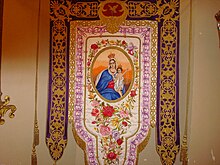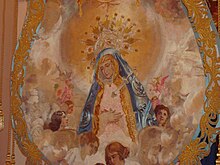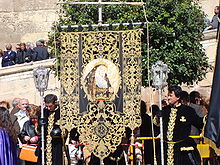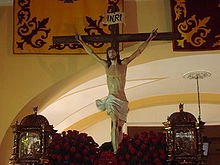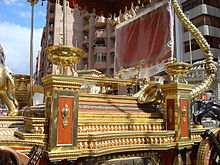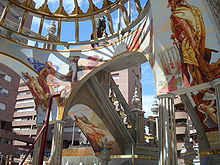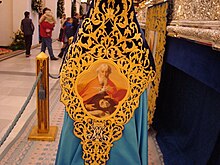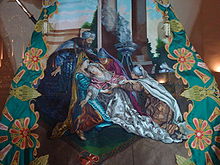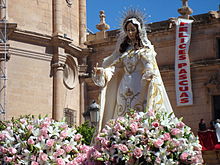Holy Week in Lorca
The Holy Week in Lorca is one of the most prominent popular manifestations of the celebration of Holy Week in Spain, having been declared a festival of International Tourist Interest in 2007 Currently, intensive work is being done on the candidacy to be shortlisted for the declaration as Intangible Cultural Heritage of Humanity by UNESCO.
Apart from the existence of religious processions in the traditional way, it is the Passionate Biblical Parades that give Lorca Holy Week a unique and different personality, with representations of the Old Testament or Christian symbology or with the participation of horses and carts, as well as carriages of enormous dimensions.
Silk embroideries are also an outstanding feature of Lorca processions, marked by an extraordinary rivalry between two of their brotherhoods or steps, the Blue and the White.
Although many of their processions are older, the history of Biblical-Passion Parades as we know them dates back to the turn of the century XIX, growing since then until reaching the splendor of our fingers.
The Stage of Courtships
Although some of its processions (those of an exclusively religious nature) pass through various streets of the city, the four great biblical-passionate parades (Dolores Friday, Palm Sunday, Holy Thursday and Good Friday) are framed by Avenida of Juan Carlos I, the most prominent of the city's roads.
For this, it is conditioned in the days prior to Holy Week with the placement of a layer of earth on the asphalt that allows the horses to run without risk. On both sides stands are placed along the entire length (approximately 600 meters) of the Avenue. Similarly, large spotlights reinforce the lighting of this road.
Access to these stands requires prior purchase of the corresponding passes.
The decoration of the stands and many of the balconies with white or blue flags are complemented by the handkerchiefs waved by the attendees, making the scene of the processions of Lorca dyed with the two main colors that star in their Holy Week.
The Brotherhoods or Steps
Holy Week in Lorca is organized around six brotherhoods, called "Pasos". All in all, the White and Blue Steps capitalize on the prominence of this Holy Week and "divide in two" to the people of Lorca in high-profile confrontations. They are the only steps that incorporate moving horses and biblical groups.
The Lorca Holy Week Brotherhoods are:
- Very Ilustre Cabildo de Nuestra Señora la Virgen de la Amargura en la Real y Muy Ilustre Orden-Archicofradía de Nuestra Señora del Rosario (Paso Blanco)
- Brotherhood of Labradors (Blue Pass)
- Archive of the Holy Christ of the Blood (Paso Encarnado)
- Confraternity of the Holy Christ of Forgiveness (Paso Morado)
- Brotherhood of the Curia (Black Pass)
- Archive of the Risen Jesus
White Step
The origins of the Royal and Illustrious Archconfraternity of Our Lady of the Rosary are traditionally considered to date back to the XV, although the oldest documents that refer to it date from 1574. It is considered the oldest brotherhood of Holy Week in Lorca. The Brotherhood is reorganized in 1753, when it organizes the Good Friday procession with the participation of images of a Nazarene, Saint John the Evangelist, Saint Mary Magdalene and Veronica, together with the images of Our Lady of the Rosary and the Virgin of Bitterness, by Francisco Salzillo. The color was purple. Its current shield also dates from those years, an eagle holding a rosary on a red background, on top of the shield there is a crown of gold and red, just below the shield, some golden branches surrounding it.
Acquired the title of Royal for the entry into it of King Ferdinand VII. In the XIX century they changed their color to the one that currently characterizes them and gives them their name: white, when in 1852 a group of Nazarenes with this color within the Archconfraternity renowned as Very Illustrious Cabildo de Nuestra Señora la Virgen de la Amargura in the Royal and Very Illustrious Order-Archconfraternity of Nuestra Señora del Rosario (Paso Blanco)
Since 1855, the Paso Blanco has carried out a procession on Palm Sunday, staging, with the Hebrew People, the Entry of Jesus into Jerusalem and its patron Saint John the Evangelist. But so does Friday of Dolores, Holy Thursday and Good Friday, the latter being its most important day, since it is when the owner of the Paso, Nuestra Señora la Virgen de la Amargura, takes a procession.
After the destruction of his heritage in the Spanish civil war (1936-1939), the new Titular image of the Virgen de la Amargura would be entrusted to Amadeo Ruiz Olmos who made said image that was replaced by another by José Sánchez Lozano who made the first image that was not very popular in Lorca and the Paso Blanco turned it into Santa Mujer Verónica, finally he made the image that currently parades. But not only the Paso Blanco is characterized by this, but also by a great history in what corresponds to musical bands. The first to be founded in 1863 was the so-called “Banda Blanca”. Later in 1973 the Band of Bugles and Drums was founded, they paraded in Roman costumes. It is also at this time that the current hymn of Paso Blanco is composed: “El Tres”. In 2004 the current “Agrupación Musical Nuestra Señora la Virgen de la Amargura” was created directed by D. Francisco Javier García Zafra, and which consists of more than 100 members, it is the oldest band that performs in processions in lorca. It has the following images:
- Blessed Virgin of the Amargura (José Sánchez Lozano, 1949)
- San Juan Evangelista (Antonio Castillo Lastrucci, 1960s)
- Holy Veronica (José Sánchez Lozano, 1950)
- Christ of the Rescue (José Sánchez Lozano, 1985)
- Prayer in the Garden (José Hernández Navarro, 2000)
We can highlight the Embroidery Museum (MUBBLA) within Paso Blanco. Collect a large sample of the best silk and gold embroidery that El Paso has, as well as samples of other objects. The MUBBLA is located in the Monumental Complex of Santo Domingo, headquarters of the brotherhood.
Blue Step
The origins of the Paso Azul can be traced back to the Archconfraternity of the True Cross and Blood of Christ, created in the 17th century XVI. Within this brotherhood there is knowledge of the existence in 1752 of the so-called Brotherhood of Lorquin Farmers, whose Head is Nuestra Señora de los Dolores, and based in the Franciscan convent.
Since the year 1800, it has presided over the Friday of Sorrows procession and in 1854 the Paso de Nazarenos Azules was created within it. In 1856 they began to incorporate high-quality embroideries into Lorca processions.
After the disappearance in the Civil War of its titular image, the work of local sculptor Manuel Martínez in the XVIII century, The current image of the Virgen de los Dolores would be entrusted to the renowned sculptor based in Madrid, José Capuz, inspired by the banner of "el reflejo", a representation of the face of the original image of the Virgin, which it is known that, during the Civil War, a Franciscan friar hid it so that it would not be destroyed, so well that it has not been found even today. It is thought that it must be in some corner of San Francisco.
The Throne of the Blessed. Virgen de los Dolores is made of sterling silver, hand-carved during two years of work in the workshop on Pureza street of the famous Sevillian goldsmith who was for many years foreman of La Esperanza de Triana D. Juan Borrero. Premiered on Friday of Dolores in 2007, when D. José Antonio Mula García was president of Paso Azul, it is the first canopy throne to come out on the shoulders during Holy Week in Lorca.
El Paso Azul has 2 more images apart from the headline: The Christ of the Good Death or Recumbent Christ, the work of the Murcian sculptor José Planes that takes place in a procession on Good Friday afternoon through the streets of Lorca on a throne made in the workshops of the Sevillian carver Manuel Guzmán Bejarano. And the Christ of the Coronation of Thorns made by José Antonio Navarro Arteaga, which parades on Maundy Thursday enthroned on a litter, also made of mahogany wood, hand-carved for two years in the workshops of Manuel Guzmán Bejarano, its eight medallions, the cross and the four lanterns are made of silver in the workshop D. Eleuterio Aragón in Motril, year 2001. The procession powers of Christ are made of silver and topaz by the master goldsmith D. Juan Borrero.
In 2009, under the presidency of Mr. José Antonio Ruiz, the Agrupación Musical Mater Dolorosa was founded, directed by José Jorge Miñarro and made up of nearly 70 members. In addition to this musical formation, the Paso Azul has 3 more bands: La Banda Romana, which maintains the Lorca tradition of drums and cornets. The Egyptian Band, made up of the youngest musicians from El Paso and finally the Banda del Cristo Yacente, which is the only band in Lorca made up exclusively of percussion instruments. The Paso Azul Anthem is popularly known as "Las Masks". It has the following images:
- Blessed Virgin of the Dolores (José Capuz Mamano, 1942)
- Christ of Good Death (José Planes Peñalver, 1945)
- The Crowning of Thorns (José Antonio Navarro Arteaga, 2001)
Since 2015, Paso Azul also has its own embroidery museum, known as MASS or Blue Museum of Holy Week, located in the old San Francisco Convent. With its more than 3,500 m², this museum is the largest museum in the Region of Murcia and it exhibits, among other things, the representative embroideries of the brotherhood.
Red Step
There is evidence of the existence in 1555 of the Brotherhood of the Holy Vera Cruz and Blood of Christ, which carried out processions on Holy Thursday and would be officially founded by the Franciscans in 1590.
In 1734 its rank was raised to Archconfraternity, being constituted in the Franciscan convent, where it had its own chapel.
During the refounding and reorganization of brotherhoods that took place in Lorca in the mid-19th century, the Brotherhood of Nazarenes Coloraos joined it, which had been founded in the convent of San Diego, becoming its Head a Crucified known as the Christ of Third Parties. It would end up disappearing in 1904.
In 1935, it was refounded in the San Diego convent, organizing for the first time the Procession of Silence, at zero hours on Good Friday.
In 1940, the Archicofradía del Santísimo Cristo de la Sangre moved its headquarters to the parish church of San Cristóbal. It has the following images:
- Christ of the Blood (José Jeriqué Chús, 1948)
- Blessed Virgin of the Soledad (José Sánchez Lozano, 1963)
- Christ of Penance (José Hernández Navarro, 1999)
Purple Step
At the beginning of the XVIII century, a chapel dedicated to the Holy Christ of Help was created in the convent of San Juan de Dios. In 1758, with said Holder, a brotherhood would be founded, which in 1779 adopted the color purple as its own.
In 1800, as "purple Nazarenes pass" He begins to preside over the afternoon procession on Holy Thursday, with his main image, that of a Sorrowful Lady and the Holy Supper, the work of Nicolás Salzillo, acquired from the Murcian brotherhood of Jesus in 1763.
Its Holder would, over the years, become the Most Holy Christ of Forgiveness, a Nazarene carrying the cross. The brotherhood has the following images:
- Christ of Forgiveness (Roque López, 1787)
- Holy dinner (Jesus and 11 apostles of Nicholas Salzillo, 1700 and an apostle of Joseph Jeriqué Chús, 1953)
- Blessed Virgin of Piedad (Antonio García Mengual, 1982)
- Mount Calvary (Cristo crucified (1947) Saint John (1942) and Saint Mary Magdalene (1942) by Manuel Juan Carrillo Marco; the Virgin of the Dolores (1790) by Marcos Laborda Gil)
- Christ of Mercy (Isabel Biscar, 1944)
- Christ of Help (Manuel Juan Carrillo Marco, 1964)
In addition to its participation in the biblical-passionate parades, the Brotherhood of the Holy Christ of Forgiveness, the Paso Morado, organizes the Via Crucis on Friday morning Santo, with its characteristic "rezaores".
Black Step
The Brotherhood of La Curia also has its remote origins, in this case in the brotherhood of Nuestra Señora de los Dolores in Paso del Prendimiento, founded in 1725, a brotherhood that would be reorganized in 1874 by the College of Lawyers and Solicitors, a circumstance from which its current name comes. He would preside over the Holy Wednesday procession until 1932.
After the Civil War, its new titular image will be the Virgen de la Soledad. The color that characterizes it today comes from its substitution in those years of the defunct brotherhood known as the black-servites, which was constituted in the church of San Mateo, for this reason it is known as the Paso Negro. For this reason, they preside over the procession (biblical parade of passion) on Palm Sunday. The title image of her:
- Blessed Virgin of the Soledad (José Sánchez Lozano, 1951)
In 1977 they moved from San Mateo to San Patricio, organizing since then the procession to its Holder on the night of Passion Saturday.
Archconfraternity of the Risen One
Even with historical background of the celebration of the Resurrection as early as 1601, the first known constitutions of this Archconfraternity of Risen Jesus date from 1764.
The first procession of the Risen Christ leaves, however, in 1801 already with the Titular image, the work of the Murcian image maker Roque López. It was one of the few images that survived the Civil War. The archconfraternity has the following images:
- Risen Christ (Roque López, 1801)
- Blessed Virgin of the Incarnation and Assumption (José Jeriqué Chús, 1941)
Although its founding seat was the church of Santa María, when it was left in ruins after the Civil War it was moved to the former collegiate church of San Patricio.
Biblical-Passion Processions and Parades
Friday of Sorrows
The first of the biblical-passionate parades runs through the streets of Lorca on the afternoon of Friday of Dolores. It dates from 1800 and is presided over by the Paso Azul, which on that day commemorates the festivity of its Owner, the Virgen de los Dolores.
El Paso Azul displays a large part of its artistic heritage, such as the banners of Cayuela, which date from the beginning of the XX century: The Veiled Angel, Saint John, Mary Magdalene and The Reflection. They are listed as BIC.
The throne of the Virgen de los Dolores, with the image made in 1941 by José Capuz under the canopy embroidered in silk by Francisco Cayuela, closes the Friday of Dolores parade. The image is accompanied by an escort of 12 Nazarenes, the 7 Sorrows of the Virgin and the Four Evangelists with the Archangel Saint Gabriel on horseback as witnesses of the Redemption. Hundreds of women with mantillas precede her, dressed in rigorous mourning.
Passion Saturday
The outskirts of the old Collegiate Church of San Patricio, the old streets around Lorca's Plaza de España, host the procession of the Curia on Passion Saturday night, organized by the Paso Negro.
This is a traditional procession, not a biblical parade. Austerity is a basic element of it, in which, on simple litters, the image of the Virgen de la Soledad, the work of José Sánchez Lozano, is in procession. The representations of the rest of the steps are limited to the presence of their banner and their musical groups.
Palm Sunday
The second Biblical parade of the people of Lorca takes place on the afternoon of Palm Sunday in a procession that, still presided over by the Brotherhood of the Curia, has as main protagonist the Jewish people, from Paso Blanco.
The Biblical representation of the Paso Azul is Roman, Ethiopian and fundamentally Egyptian, highlighting the figures of Pharaoh Ramses II and Princess Meiamen, who saved Moses from the waters of the Nile. Within the Group of the Pharaoh the 4 Egyptian chariots also appear.
The Biblical representation of the Paso Blanco is Hebrew, highlighting the kings David and Solomon, accompanied by their entourage and the most characteristic group of this procession, the Hebrew People, who have walked the streets of Lorca on Palm Sunday since 1855. They participate thousands of white men and women dressed in tunics, to celebrate the entry of Jesus into Jerusalem, carrying palms, olive branches and distributing sweets. Behind them parades, on a throne of litters, with an ornamentation of palms, the image of San Juan Evangelista by Castillo Lastrucci (1973) on the shoulders of his pasapasos to the rhythm of the Musical Group Nuestra Señora la Virgen de la Amargura.
The procession closes with the titular image of the Paso Negro, the Virgen de la Soledad, escorted by toga-wearing butlers, a tradition of this Brotherhood, made up of members of the judiciary. The cloak is a work made of black velvet, embroidered in gold and silk. In the upper part it presents two shields embroidered in gold: on the right the Lorca City Council and on the left the Lorca Bar Association. In the lower part, it shows three medallions embroidered in silk: the central medallion represents an image of piety, inspired by Michelangelo's Pietà, and two smaller medallions on the sides that represent angels, inspired by the iconographic model of the Sistine Chapel..
Holy Thursday
Passionate Biblical Parade
On Holy Thursday the first of Lorca's two great biblical parades takes place. In the blues and whites, a large number of elements on horseback will be brought out onto the street, complete groups of Egypt, the Jewish people or symbols of the Triumph of Christianity, as well as some of the large floats that completely occupy the width of Avenida Juan Carlos I.
We can highlight two aspects within this procession: the biblical procession, which tonight represents the suffering of the Hebrew people at the hands of the civilizations that subdued them, such as Egypt, Babylon and Rome; and its religious and passionate sense, which reflects the suffering of Jesus during the Last Supper, at which time he institutes the Sacrament of the Eucharist, intuiting his own death.
Characterizing the characters of the Old Testament, the members of the Lorca brotherhoods, dressed in rich cloaks, parade on horseback, in bigas, chariots, follow and floats.
The Brotherhood of the Holy Christ of Forgiveness, the Purple Paso, has presided over the Holy Thursday procession since the year 1800. This afternoon it displays all its artistic heritage in the so-called Forgiveness Procession. First of all, its four thrones stand out in this order: Last Supper, by Nicolás Salzillo (1700) and José Jerique (1953), Jesús Nazareno del Perdón (Roque López, 1787), Monte Calvario (anonymous, Dolorosa attributed to Roque López, 1802 and Manuel Carrillo, 1942) and María Santísima de la Piedad (Antonio García Mengual, 1982). Also featured in the procession is the image of the Santísimo Cristo de la Misericordia (Isabel Biscar, 1944), carried on the shoulders of the Hermanos del Socorro.
Procession of Silence
At the end of the Biblical Parade on Holy Thursday afternoon, the procession of Silence leaves from the Barrio de San Cristóbal, a totally different procession, without biblical groups, organized by the Paso Encarnado.
Three images procession this day: the Lord of Penance, a work by José Hernández Navarro in 1999, the Virgin of Solitude (José Sánchez Lozano, 1963) and the Head of the Brotherhood, the Blood Christ (José Jerique Chus, 1948). The three images travel through the streets of the neighborhood in an atmosphere of strict religiosity. All the brotherhoods take part in the procession with their banners-script and a representation of the Coloraos de Murcia. The silence is only broken by the voice of the santeros accompanied by the melody of the Agrupación Musical Stmo Cristo de la Sangre.
Good Friday
Good Friday is the most important day of Holy Week in Lorca. However, before beginning the tour of the headquarters of the steps to see the exhibition of the items that will procession in the Biblical Parade in the afternoon, the Via Crucis to Calvary takes place.
Way of the Cross to Calvary
On the morning of Good Friday, the Paso Morado organizes a Stations of the Cross in which three images of this Brotherhood are carried on a litter (San Juan, the Blessed Christ of Socorro and La Dolorosa) and with them they go to a commemorative hermitage del Calvario on the outskirts of Lorca. The prayer of the seasons has been done in a peculiar way since ancient times by the so-called "rezaores". Monte Calvario together with the Via Crucis was declared BIC.
Passionate Biblical Parade
Good Friday is the most important of the parades that take place during Lorca's Holy Week. Thousands of people attend it, which is also the busiest for the different brotherhoods of Lorca, who come to it with the highlights of their heritage.
The procession is presided over by the Most Illustrious and Cavildo of Our Lady the Virgen de la Amagura in the Royal and Most Illustrious Order-Archconfraternity of Our Lady the Virgen del Rosario Paso Blanco with its banner Guion. Next, the Incarnated Step parades with the images of the Santísima Virgen de la Soledad Coronada and the Santísimo Cristo de la Sangre.
The Purple Step intervenes with its Procession of the Virgen de la Piedad and the Head of the Brotherhood.
The procession of the Blue Passage represents the path traveled by the patriarch Moses and his people, passing through the civilizations of Egypt and Rome until reaching the final destination, the Triumph of Christianity and the Redemption of Humanity. The procession of the Paso Azul opens with the banner of the Santísima Virgen de los Dolores followed by the explorers sent by Moisés to the promised land. The Roman infantry and the first flag of the pass introduce the characters of Antiochus IV Epiphanes, the prophetess Deborah and Ptolemy IV Philopator. The entrance of the Pharaoh of Egypt arrives accompanied by his Ethiopian cavalry, Moses, Meiamen and the Egyptian prophetesses. Rome with the horse-drawn chariot of the Emperor Julius Caesar, Cleopatra, who parades in a large litter, the Egyptian cavalry, and Nero (in a huge chariot that monopolizes the entire race). After the chariots of the Flavian Dynasty, the Roman cavalry and Tiberius announce the arrival of the Triumph of Christianity, represented by the Triumph Cavalry and the Chariot of the Fallen Angel.
After the blue biblical representation, six satin Nazarenes introduce the passionate procession: The Triumph of Redemption.
The The Holy Cross arrives, the Great Penitent, Simeon and Pilate announcing the drama. The banner of the Cristo Yacente, the work of Emiliano Rojo, the Nazarenes who follow him and the deacons, precede the image of the Santísimo Cristo de la Buena Muerte on a throne carried on a litter For 90 steps, he is accompanied by the Drum Band and three Nazarenes. Next, the banners of The Veiled Angel, San Juan y la Magdalena and El Reflejo, named for being the spitting image of the ancient carving of the owner Azul, by José Manuel Martínez Castillo from Lorca, who disappeared in the Spanish civil war. The 12 Nazarenes of the Virgin and a guide cross precede the Throne on a litter carved in silver and ivory of the Sacred Image of the Blessed Virgin of Sorrows. The 7 Nazarenes representing the 7 Sorrows of the Virgin, the Four Evangelists who escort her on horseback and the closing Nazarenes close the Cortejo.
The Guion banner of the Black Passage separates the Blue Procession from the White Procession.
The White Pass culminates this procession with the Salvation Procession, the road to it through the Roman, Babylonian, Assyrian and Persian civilizations, present in the Old Testament, all of them oppressors of the Jewish people, until finding it in the Gospel according to Saint John, in the New Testament.
The Cortejo Blanco begins with the Banner of the Rosary, the Flag of the Paso Blanco and the Nazarenos of the Cabildo. The group from Rome arrives with the quintiga of Octavio César Augusto, the chariots of Theodosius I The Great, Licinius and Constantine I the Great and finally the follow of Maxentius.
He is followed by the group on horseback made up of Saint Helena, Constantius Chlorus and Fausta, then a Roman cavalry made up of a legate and five tribunes. The set of Rome the Imperial Cavalry made up of Maximian, Diocletian, Maximino Daya, Julian the Apostate and Galerius came to an end.
Before Rome Babylon falls, represented by the group of King Nebuchadnezzar II in a chariot pulled by slaves. According to the Old Testament, Esther, born in Babylon, married the Persian king Ahasuerus. He issued an extermination order against the Jewish people, a law that he repealed when he found out that his own wife was Jewish. Esther made it public and thereby saved her life and that of thousands of innocent people. This story is represented by the group of Esther and Ahasuerus, in bigas, preceded by the Persian infantry and the Court, and followed by the group's cavalry, made up of eight horsemen.
The tribes of Israel arrive, first King David's party, made up of the king himself, his wives' cavalry, and Jewish infantry. Then the group of King Solomon, who parades on a beam, preceded by his court and the Horse of Respect , the only one without a saddle. He is followed by the king's cavalry and his heralds. This is followed by the group of the Queen of Sheba, made up of Menelik I's biga, the queen's court of slaves and the Queen of Sheba herself in a spectacular carriage. The biblical procession closes with the Group of the Schism of the Tribes of Israel: the cavalry of the 10 tribes of the Northern kingdom, led by Jeroboam in a triga; and the cavalry of the 2 tribes of the South, with Rehoboam in a biga and the Chiefs of the Tribes.
The White Religious Procession arrives, the Salvation Procession, a reflection of the Gospel according to Saint John, Patron Saint of Paso Blanco.
The centenary Flag and the Nazarenes of the Cabildo introduce the Religious Procession and announce the arrival of the Group of the Apocalyptic Vision of San Juan.
The Standard of San Juan and his Nazarenes arrive. Next the Cavalry of the Vision of Saint John, then the Chariot of the Vision of Saint John and behind it the four horsemen of the Apocalypse.
Behind them is the carving of the Evangelist, Saint John, on a throne of litters. The throne holders parade following the guidelines set by the Nuestra Señora la Virgen de la Amargura Youth Musical Group dressed as Romans, making two laps in the race, the first accompanies the Roman Infantry of Paso Blanco and the second accompanies the patron of this brotherhood, Saint John the Evangelist. After this Sanjuaista group arrives the Banner of the Holy Face and the Nazarenes of Saint Veronica who precede the image of the Saint Woman Veronica on the throne of andas made of silver and carried by women carrying pasasos.
Ultimately, the Banner of the Holy Virgin of Bitterness appears. Next, the Nazarenes representing the Mysteries of the Rosary, whose embroideries recall different architectural styles, precede the throne of the Holy Virgin of Bitterness. The reconfiguration of the narrative sequence of the Good Friday procession in Baroque times involved the incorporation of the dedication of the Virgen de la Amargura, designed to represent the scene immediately after the death of Jesus. It is a carving made in the likeness of the original by Salzillo, which disappeared in the Spanish civil war. The beautiful image of the Virgen de la Amargura is due to the gouge of the Murcian image maker José Sánchez Lozano, the search for beauty and a certain naturalism idealized typical of the sculptor Sánchez Lozano, brings her closer to an exquisite beauty that brings us closer to God and invites devotion to a perfect mother.
Only processions on Good Friday night.
The Virgen de la Amargura wears the cloak with the largest embroidered extension of all those who parade in the Lorca procession, making it impossible to see the cloth on which it was embroidered (all of it is an immense tapestry) made by Emilio Felices. in 1928. In the central part the Holy Burial of Ciseri is represented. The group is made up of the figures of Saint John, Saint Joseph of Arimathea and Saint Joseph Nicodemus, who carry the lifeless body of Jesus on the Shroud, and those who are accompanied by the Virgin Mary and Magdalene. Below the main scene is a version of The Angel of the Eucharist by Giambattista Tiepolo and two large side veils that, dotted with angels and cherubs, show the burial of the Savior of Humanity as if it were a great theater. At the top, God the Father is represented. The rest is embroidered with clouds and angels, and a large border borders the entire mantle.
The canopy of the Virgin is also the work of Emilio Felices in 1915. Wrapped in traces of Gothic style and framed in a rose window we find a version of Felices de Cristo coronado de thorns, an original work by Guido Reni articulating the composition flanked by two larger scenes and a mixtilinear frame. In the first of them and in the area to the left of the viewer, Christ and Saint John, his beloved disciple, are represented, figures versioned from the oil painting Christ and Judas, whose author is Adolf Schmitz, inverting their position in this case so that they better fit the irregular triangle space. The well-known image of the angel carved by Salzillo in 1754 for the sculptural group of La oración en el huerto appears embroidered in the area on the right. The figure presents great strength and movement marked by the diagonal composition that props up the extended wing and the arm indicating the direction to Heaven. The whole of the frontal cloth is closed with an elegant gold scalloping of Gothic cut and openwork of paired cardinas finished off in gold tassels. On the front cloth appears: Jesus and Saint John at the Last Supper. The Angel of Salzillo. And the face of Jesus crowned with thorns in the central medallion.
This procession closes with the Mayordomos de la Virgen de la Amargura and the Nuestra Señora la Virgen de la Amargura Musical Ensemble dressed in maximum gala attire, with a white feathered helmet and a costume inspired by the Royal Guard (This costume is only worn when the Virgen de la Amargura comes out).
Easter Sunday
On the morning of Easter Sunday, the last of Lorca's processions takes place: the Resurrection procession, which, starting from the Collegiate Church of San Patricio, runs through part of Lorca's historic center with the images of Our Risen Lord Jesus (Roque López) and Blessed Mary of the Incarnation and Assumption (José Jerique Chús, 1941).
Other important events of Holy Week in Lorca
Apart from the biblical parades and processions, some acts of Lorca's Holy Week are also extremely outstanding.
The first of them, the Serenade to the Virgen de los Dolores, takes place on the eve of Friday of Sorrows, when at the last minute of it, thousands of blues congregate at the door of the church of San Francisco, headquarters of his Brotherhood to congratulate in his own way his Holder in what will be, at twelve o'clock at night, his festivity.
There is also a characteristic act of Holy Week in Lorca that takes place every afternoon, on the eve of the Biblical parades. The flags of the steps have been placed in certain places in the old town of Lorca, where the Roman squad and a group of mayordomos, to the sounds of the hymns of the steps ("El Tres" in the case of the whites, "Las Caretas" in the blue ones) go to collect them accompanied by hundreds of enthusiastic followers, who carry and wave handkerchiefs with the colors of their passage.
On Holy Tuesday at 11:00 p.m. in the Plaza de la Estrella in the San Cristóbal neighborhood, there is a gathering of images of the Archconfraternity of the Holy Christ of the Blood (Paso Encarnado) in which the Images of La Blessed Virgin of Solitude, Our Father Jesus of Penance and the owner of this brotherhood The Blessed Christ of the Blood.
Finally, on the morning of Good Friday, the Paso Morado organizes a Via Crucis, which takes place following the ancient prayers pronounced by the "rezaores".
Contenido relacionado
Annex: Classification of musical instruments
Judea (Roman province)
Blues
